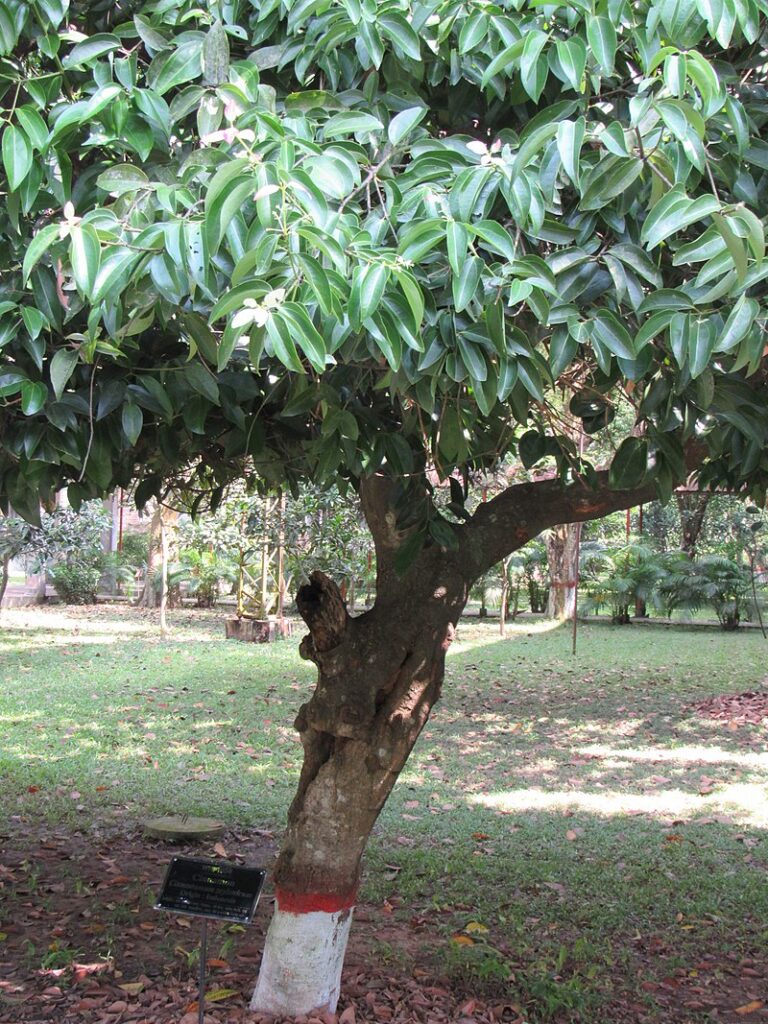
Wikimedia, Afifa Afrin, CC BY-SA 3.0
Seychelles
Cinnamon
Cinnamomum zeylanicum

Wikimedia, Afifa Afrin, CC BY-SA 3.0
General Description / Cultural Significance
Cinnamon (Cinnamomum zeylanicum), also known as Ceylon cinnamon or “true cinnamon,” is a prized evergreen tree native to Sri Lanka and southern India but cultivated in tropical regions worldwide, including the Seychelles. The tree is highly valued for its fragrant inner bark, which, when dried and curled into quills, becomes one of the most cherished spices in the world. In Seychelles, cinnamon thrives in the warm, humid climate, contributing to the island nation’s lush biodiversity. With its glossy green leaves, clusters of small white flowers, and distinctive scent, cinnamon is both an aesthetic and economically significant plant.
Culturally, cinnamon is deeply interwoven with Seychellois heritage, reflecting the islands’ historical ties to the spice trade. Introduced to Seychelles in the 18th century by French settlers, cinnamon quickly adapted to the environment, becoming a naturalized and widely cultivated species. It has since played a vital role in the local economy, cuisine, and traditional medicine. The aromatic bark is a staple ingredient in Seychellois Creole dishes, enhancing the flavors of curries, stews, desserts, and spiced teas. The essential oil extracted from its bark and leaves is used in traditional remedies for its anti-inflammatory, antimicrobial, and digestive benefits. Locally, cinnamon oil is also incorporated into beauty products and wellness therapies, reinforcing its reputation as a versatile and beneficial plant.
Beyond its practical applications, cinnamon holds symbolic value in Seychellois culture, representing the island’s connection to nature and its rich botanical heritage. The tree’s resilience and ability to flourish in the Seychelles’ tropical environment serve as a testament to the islands’ enduring relationship with the land and sustainable agricultural practices.
Climate Change / Conservation Status
While cinnamon is not currently considered an endangered species in Seychelles, its presence in the wild and cultivated landscapes faces potential threats from deforestation, climate change, and habitat loss. Rising temperatures and shifting rainfall patterns could impact its growth and productivity, altering both its naturalized distribution and commercial cultivation. However, cinnamon remains an integral part of Seychelles’ biodiversity and agroforestry efforts.
Sustainable agriculture initiatives in the Seychelles support the responsible cultivation of cinnamon, emphasizing organic farming practices and biodiversity conservation. While not the target of specific conservation programs, cinnamon trees contribute to soil stability, reforestation projects, and agroforestry systems that aim to balance economic and ecological sustainability. The government and local environmental organizations promote policies that ensure cinnamon and other valuable plant species are preserved for future generations, aligning with broader biodiversity conservation goals.
Alternate Names
Ceylon Cinnamon
True Cinnamon
Seychelles Cinnamon
Sources
“All About Cinnamon.” 88 Acres, 88 Acres, 2025, 88acres.com/blogs/news/all-about-cinnamon#:~:text=%EF%BB%BFAns%3A%20The%20growth%20cycles,cinnamon%20tree%20to%20fully%20develop.
“Cinnamomum Verum.” Cinnamomum Verum (Ceylon Cinnamon, Ceylon Cinnamon Tree, Cinnamon, Cinnamon Bark Tree, Kayu Manis, True Cinnamon) | North Carolina Extension Gardener Plant Toolbox, NC State, 2019, plants.ces.ncsu.edu/plants/cinnamomum-verum/#:~:text=Young%20trees%20will%20perform%20at,as%20indoors%20as%20a%20houseplant.
Permanent Mission of the Republic of Seychelles to the United Nations

